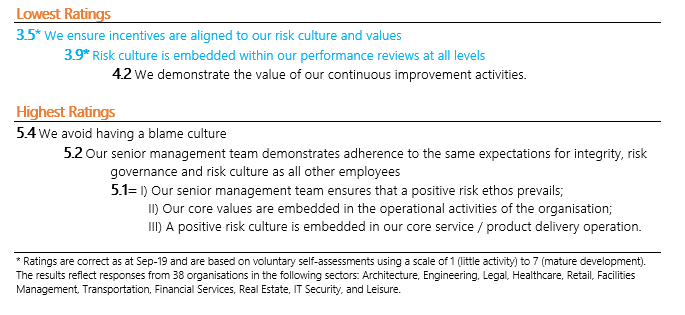Reward and recognition: how to design a framework that encourages a positive risk culture

Data reveals that organisations are struggling to use financial incentives to promote a positive risk culture. Risk professionals are well-placed to turn this round, argues Deborah O'Riordan of QBE Risk Solutions, who offers practical advice on how to implement change.
Since QBE launched its Risk Culture Profiling Tool in 2015, QBE customers and Airmic members have benefitted hugely from the insight gained on risk culture in their organisations. The tool is designed to help businesses assess and benchmark its existing culture; understand best practice; and create an action plan to develop a positive corporate culture.
Since its launch, the tool has been collecting data on how companies perform on key areas of risk culture. One area that has consistently stood out as the lowest performing in our evaluation ratings is that of Reward and Recognition. This is the section of the tool that looks at how employees are incentivised to adopt and demonstrate behaviours that support a positive risk culture.
Having discussed this finding with our customers, it appears that whilst there is a general acceptance of the need to instigate change, reward and recognition is not seen as enough of a priority compared to the many other pressing risk management needs. Another barrier is that many organisations are unclear how to instil change at a practical level.
Risk culture, best and worst performing areas:


Reward is a key driver of behaviour
Having the right link between rewards and risk culture is essential but seems to be lacking in some organisations. Risk professionals should take the initiative to open discussions with their management colleagues in analysing rewards and incentives and devising and launching effective incentives that really will reduce risk.
This is a critical area to address in order to build a robust risk culture, as reward is such a key driver and impacts on every individual in the organisation. It is important that risk professionals ensure expectations for behaviours are clearly defined, achievable, have a clear and transparent link to reward.
Knowing which practical steps to implement can be a challenge. The following checklist offers some key principles and considerations for developing a strong incentive framework to encourage behaviours that reflect core values and support a robust risk culture. Any or all can be adopted but it is recommended that at least one in each of the 10 sections is addressed.
Top 10 Checklist for an Incentive Framework
| Key Principles | Practical Considerations |
| 1. Senior Management Commitment |
|
|
|
|
|
|
|
|
|
|
|
| 2. Clear Reward & Recognition Policies |
|
|
|
|
|
| 3. Link process controls to Risk Culture |
|
|
|
| 4. Recruitment for Model Behaviours |
|
|
|
|
|
|
|
| 5. Embedded thinking |
|
|
|
|
|
|
6. Realistic Targets |
|
|
|
|
|
|
7. Clear Disincentives |
|
|
|
|
8. Aligned Performance Review Process |
|
|
|
| 9. Supportive Oversight |
|
|
|
| 10. Audit Behaviours |
|
|
|
The final and continuous stage is to review the effectiveness of the measures taken. QBE has developed an example performance review framework - available to QBE clients and Airmic members via this link) - which considers behaviours in six core areas to assess how well everyone is following the organisation's benchmark risk culture behaviours. The whole framework can be adopted as is or extracts taken and built into an existing performance assessment.
Deborah O'Riordan is practice leader, financial lines, at QBE Risk Solutions.
The Risk Culture Profiling tool was developed in association with Airmic, and is available to members free of charge on request by clicking here.
